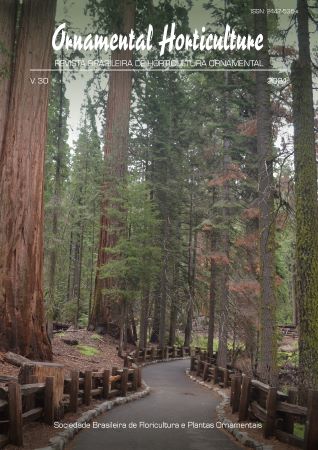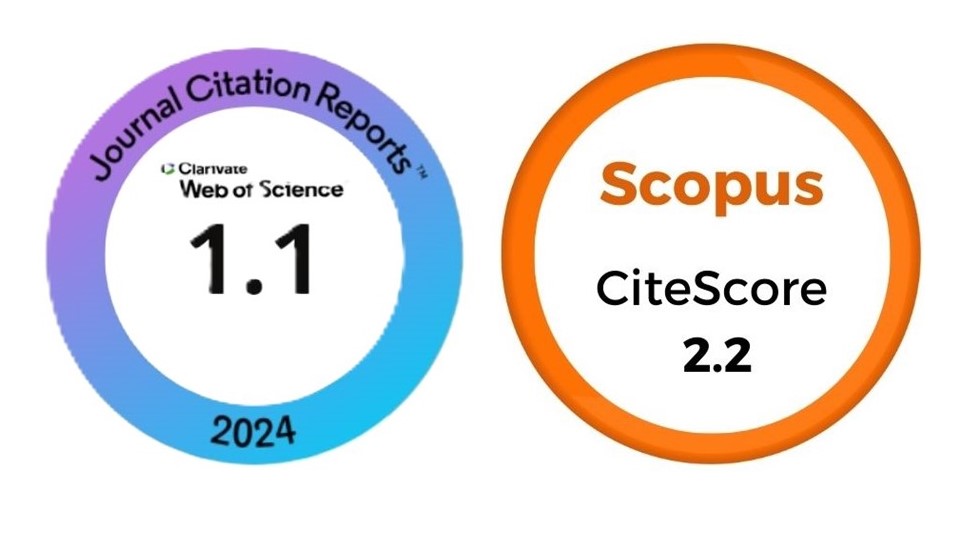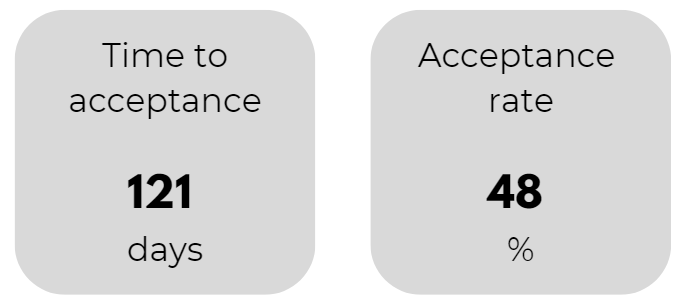Exploração quantitativa da colonização de micorrizas arbusculares em Dactylorhiza hatagirea (D.Don) Soó na Caxemira Himalaia
DOI:
https://doi.org/10.1590/2447-536X.v30.e242723Palavras-chave:
fungos micorrízicos arbusculares, nitrogênio, ciclagem de nutrientes, orquídea himalaia, fósforoResumo
As micorrizas, associadas exclusivamente às orquídeas, desempenham um papel crucial no crescimento das plantas, nas interações competitivas e na proteção contra patógenos. Este estudo teve como objetivo avaliar quantitativamente a taxa de colonização de fungos micorrízicos arbusculares (FMA) em Dactylorhiza hatagirea em três locais localizados na região de Caxemira (Himalaia) : Gulmarg, Sonamarg e Pahalgam. Além disso, examinar parâmetros do solo como temperatura, precipitação, pH, carbono orgânico, fósforo, potássio e nitrogênio. As pontas das raízes foram coletadas a uma profundidade de 0-20 cm e após armazenadas em sacos de polietileno estéreis, refrigeradas a 4±1 °C. Nossos resultados mostraram uma variação significativa na colonização micorrízica nos três locais, sendo que Pahalgam apresentou o valor mais alto com 78%, seguido por Gulmarg com 73% e Sonamarg com 57%. A Análise de Componentes Principais (ACP) revelou 69,5% de variação nas variáveis ambientais e de solo. Correlações positivas foram observadas entre pH, nitrogênio, potássio e carbono orgânico, enquanto o fósforo foi negativamente correlacionado com potássio e nitrogênio. Os locais Gulmarg e Pahalgam foram semelhantes nas características do solo, enquanto Sonamarg exibiu diferenças significativas. O fósforo correlacionou-se positivamente com Sonamarg, mas negativamente com Pahalgam e Gulmarg, enquanto outros parâmetros do solo mostraram tendências opostas. O estudo destaca a importância da colonização de FMA na compreensão e melhoria das interações planta-micróbio em ecossistemas terrestres, destacando o seu papel na ciclagem de nutrientes e na assimilação de elementos essenciais como o fósforo e nitrogênio.
Downloads
Referências
ABDALLA, M.; BITTERLICH, M.; JANSA, J.; PÜSCHEL, D.; AHMED,M. A. The role of arbuscular mycorrhizal symbiosis in improving plant water status under drought. Journal of Experimental Botany, v.74, n.16, p.4808-4824, 2023. https://doi.org/10.1093/jxb/erad249
BABIKOVA, Z.; GILBERT, L.; BRUCE, T.; DEWHIRST, S.Y.; PICKETT, J.A.; JOHNSON, D. Arbuscular mycorrhizal fungi and aphids interact by changing host plant quality and volatile emission. Functional Ecology, v.28, p.375-385, 2014. https://doi.org/10.1111/1365-2435.12181
BEGUM, N.; QIN, C.; AHANGER, M.A.; RAZA, S.; KHAN, M.I.; ASHRAF, M.; AHMED, N.; ZHANG, L. Role of arbuscular mycorrhizal fungi in plant growth regulation: Implications in abiotic stress tolerance. Frontiers Plant Science, v.10, p.1068, 2019. https://doi.org/10.3389/fpls.2019.01068
BERRUTI, A.; LUMINI, E.; BALESTRINI, R.; BIANCIOTTO, V. Arbuscular mycorrhizal fungi as natural biofertilizers: let’s benefit from past successes. Frontiers in Microbiology, v.6, p.1559, 2016. https://doi.org/10.3389/fmicb.2015.01559
BHANTANA, P.; RANA, M.S.; SUN, X.C.; MOUSSA, M.G.; SALEEM, M.H.; SYAIFUDIN, M.; HU, C.X. Arbuscular mycorrhizal fungi and its major role in plant growth, zinc nutrition, phosphorous regulation and phytoremediation. Symbiosis, v.84, p.19-37, 2021. https://doi.org/10.1007/s13199-021-00756-6
CHIU, C.H.; PASZKOWSKI, U. Mechanisms and impact of symbiotic phosphate acquisition. Cold Spring Harbor Perspectives in Biology, v.11, n.6, a034603, 2019. https://doi.org/10.1101/cshperspect.a034603
IQBAL, B.; LI, G.; ALABBOSH, K.F.; HUSSAIN, H.; KHAN, I.; TARIQ, M.; AHMAD, N. Advancing environmental sustainability through microbial reprogramming in growth improvement, stress alleviation, and phytoremediation. Plant Stress, p.100283, 2023. https://doi.org/10.1016/j.stress.2023.100283
KHALIQ, A.; PERVEEN, S.; ALAMER, K.H.; ZIA UL HAQ, M.; RAFIQUE, Z.; ALSUDAYS, I.M.; ALTHOBAITI, A.T.; SALEH, M.A.; HUSSAIN, S.; ATTIA, H. Arbuscular mycorrhizal fungi symbiosis to enhance plant–soil interaction. Sustainability, v.14, p.7840, 2022. https://doi.org/10.3390/su14137840
LEMANCEAU, P.; MARON, P.A.; MAZURIER, S.; MOUGEL, C.; PIVATO, B.; PLASSART, P.; WIPF, D. Understanding and managing soil biodiversity: a major challenge in agroecology. Agronomy for Sustainable Development, v.35, p.67-81, 2015. https://doi.org/10.1007/s13593-014-0247-0
LI, W.; LI, W.B.; XING, L.J.; GUO, S.X. Effect of arbuscular mycorrhizal fungi (AMF) and plant growth-promoting rhizobacteria (PGPR) on microorganism of phenanthrene and pyrene contaminated soils. International Journal Phytoremediation, v.25, p.240-251, 2022. https://doi.org/10.1080/15226514.2022.2071832
MBODJ, D.; EFFA-EFFA, B.; KANE, A.; MANNEH, B.; GANTET, P.; LAPLAZE, L.; DIEDHIOU, A.; GRONDIN, A. Arbuscular mycorrhizal symbiosis in rice: Establishment, environmental control and impact on plant growth and resistance to abiotic stresses. Rhizosphere, v.8, p.12-26, 2018. https://doi.org/10.1016/j.rhisph.2018.08.003
PEÑUELAS, J.; SARDANS, J. Global change and forest disturbances in the Mediterranean basin: Breakthroughs, knowledge gaps, and recommendations. Forests, v.12, n.5, p.603, 202. https://doi.org/10.3390/f12050603
PHILLIPS, J.M.; HAYMAN, D. S. Improved procedures for clearing roots and staining parasitic and vesicular-arbuscular mycorrhizal fungi for rapid assessment of infection. Transactions of the British mycological Society, v.55, n.1, p.158, 1970. https://doi.org/10.1016/S0007-1536(70)80110-3
QIN, Z.; ZHANG, H.; FENG, G.; CHRISTIE, P.; ZHANG, J.; LI, X.; GAI, J. Soil phosphorus availability modifies the relationship between AM fungal diversity and mycorrhizal benefits to maize in an agricultural soil. Soil Biology and Biochemistry, v.144, p.107790, 2020. https://doi.org/10.1016/j.soilbio.2020.107790
REZÁCOVÁ, V.; CZAKÓ, A.; STEHLÍK, M.; MAYEROVÁ, M.; ŠIMON, T.; SMATANOVÁ, M.; MADARAS, M. Organic fertilization improves soil aggregation through increases in abundance of eubacteria and products of arbuscular mycorrhizal fungi. Science Reports, v.11, p.12548, 2021. https://doi.org/10.1038/s41598-021-91653-x
ROBERTS, D.P.; MATTOO, A.K. Sustainable agriculture - Enhancing environmental benefits, food nutritional quality and building crop resilience to abiotic and biotic stresses. Agriculture, v.8, n.8 2018. https://doi.org/10.3390/agriculture8010008
SABOOR, A.; ALI, M.A.; HUSSAIN, S.; EL ENSHASY, H. A.; HUSSAIN, S.; AHMED, N.; DATTA, R. Zinc nutrition and arbuscular mycorrhizal symbiosis effects on maize (Zea mays L.) growth and productivity. Saudi Journal of Biological Sciences, v.28, n.11, p.6339-6351, 2021. https://doi.org/10.1016/j.sjbs.2021.06.096
SHARMA, K.; GUPTA, S.; THOKCHOM, S.D.; JANGIR, P.; KAPOOR, R. Arbuscular mycorrhiza-mediated regulation of polyamines and aquaporins during abiotic stress: deep insights on the recondite players. Frontiers in Plant Science, v.12, p.1072, 2021. https://doi.org/10.3389/fpls.2021.642101
SHRIVASTAVA, A.; JAIN, S. Dactylorhiza hatagirea (D. Don) Soo: Himalayan marsh orchid. In: Immunity Boosting Medicinal Plants of the Western Himalayas, 145-171. 2023 https://doi.org/10.1007/978-981-19-9501-9_6
SIDDIQUI, Z.A.; PICHTEL, J. Mycorrhizae: An overview. In: Mycorrhizae: Sustainable Agriculture and Forestry; Berlin/Heidelberg: Springer, 2008. p.1-35. https://doi.org/10.1007/978-1-4020-8770-7
UPADHAYAY, V.K.; SINGH, J.; KHAN, A.; LOHANI, S.; SINGH, A.V. Mycorrhizal mediated micronutrients transportation in food-based plants: A biofortification strategy. Mycorrhizosphere and Pedogenesis, p.1-24, 2019. https://doi.org/10.1007/978-981-13-6480-8_1
WAHAB, A.; MUHAMMAD, M.; MUNIR, A.; ABDI, G.; ZAMAN, W.; AYAZ, A.; REDDY, S.P.P. Role of arbuscular mycorrhizal fungi in regulating growth, enhancing productivity, and potentially influencing ecosystems under abiotic and biotic stresses. Plants, v.12, n.17, p.3102, 2023. https://doi.org/10.3390/plants12173102
ZAVAHIR, J.S.; WIJEPALE, P.C.; SENEVIRATNE, G. Role of microbial communities in plant–microbe interactions, metabolic cooperation, and self-sufficiency leading to sustainable agriculture. Role of Microbial Communities for Sustainability, p.1-35, 2021. https://doi.org/10.1007/978-981-15-9912-5_1
Downloads
Publicado
Edição
Seção
Licença
Copyright (c) 2024 Ornamental Horticulture

Este trabalho está licenciado sob uma licença Creative Commons Attribution 4.0 International License.








